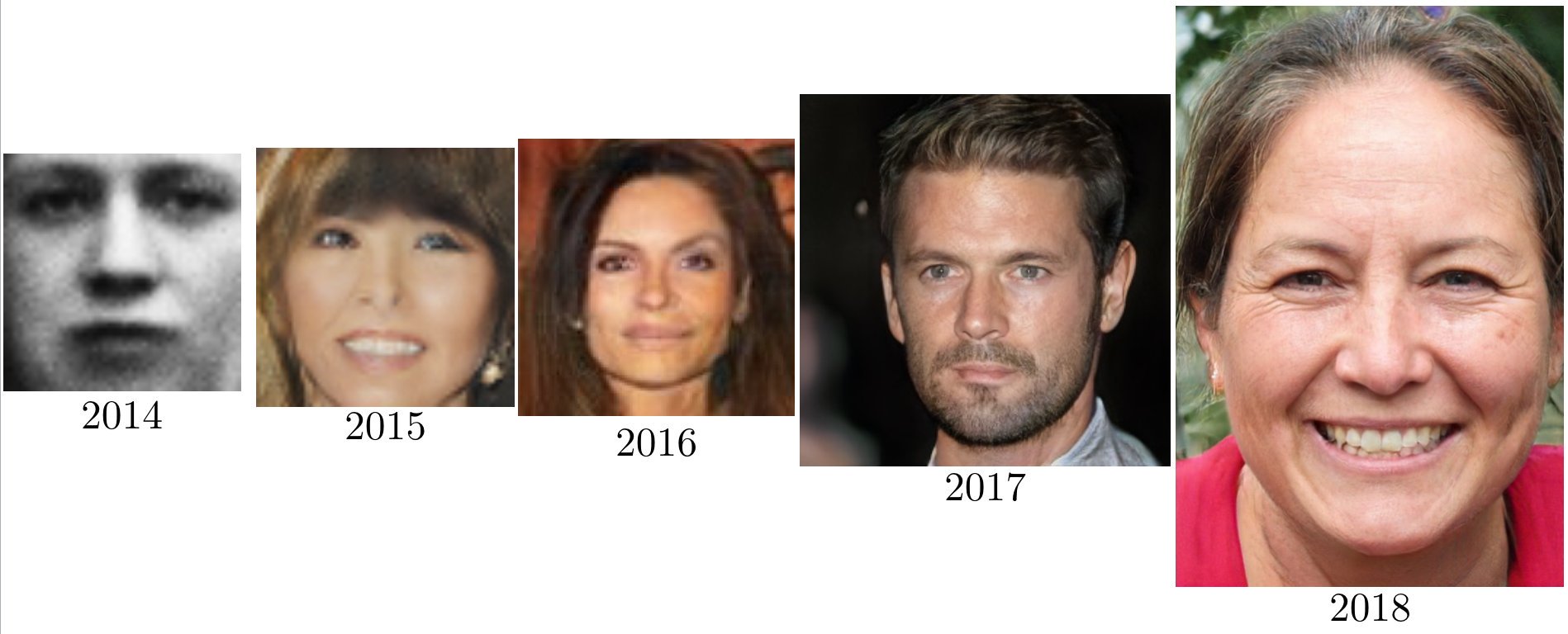GANs
Reference
- Check this kaggle competition
- Fast.ai decrappify & DeOldify
Applications:
- Image to image problems
- Super Resolution
- Black and white colorization
- Colorful Image Colorization 2016
- DeOldify 2018, SotA
- Decrappification
- Artistic style
- Data augmentation:
- New images
- From latent vector
- From noise image
Training
- Generate labeled dataset
- Edit ground truth images to become the input images.
- This step depend of the problem: input data could be crappified, black & white, noise, vector …
- Train the GENERATOR (most of the time)
- Model: UNET with pretrained ResNet backbone + self attention + spectral normalization
- Loss: Mean squared pixel error or L1 loss
- Better Loss: Perceptual Loss (aka Feature Loss)
- Save generated images.
- Train the DISCRIMINATOR (aka Critic) with real vs generated images.
- Model: Pretrained binary classifier + spectral normalization
- Train BOTH nets (ping-pong) with 2 losses (original and discriminator).
- With a NoGAN approach, this step is very quick (a 5% of the total training time, more o less)
- With a traditional progressively-sized GAN approach, this step is very slow.
- If train so much this step, you start seeing artifacts and glitches introduced in renderings.
Tricks
- Self-Attention GAN (SAGAN): For spatial coherence between regions of the generated image
- Spectral normalization
- Video
- pix2pixHD
- COVST: Naively add temporal consistency.
- Video-to-Video Synthesis
GANs (order chronologically)
| Paper | Name | Date | Creator |
|---|---|---|---|
| GAN | Generative Adversarial Net | Jun 2014 | Goodfellow |
| CGAN | Conditional GAN | Nov 2014 | Montreal U. |
| DCGAN | Deep Convolutional GAN | Nov 2015 | |
| GAN v2 | Improved GAN | Jun 2016 | Goodfellow |
| InfoGAN | Jun 2016 | OpenAI | |
| CoGAN | Coupled GAN | Jun 2016 | Mitsubishi |
| Pix2Pix | Image to Image | Nov 2016 | Berkeley |
| StackGAN | Text to Image | Dec 2016 | Baidu |
| WGAN | Wasserstein GAN | Jan 2017 | |
| CycleGAN | Cycle GAN | Mar 2017 | Berkeley |
| ProGAN | Progressive growing of GAN | Oct 2017 | NVIDIA |
| SAGAN | Self-Attention GAN | May 2018 | Goodfellow |
| BigGAN | Large Scale GAN Training | Sep 2018 | |
| StyleGAN | Style-based GAN | Dec 2018 | NVIDIA |
2014 (GAN) → 2015 (DCGAN) → 2016 (CoGAN) → 2017 (ProGAN) → 2018 (StyleGAN)
GANS (order by type)
- Better error function
- LSGAN https://arxiv.org/abs/1611.04076
- RaGAN https://arxiv.org/abs/1807.00734
- GAN v2 (Feature Matching) https://arxiv.org/abs/1606.03498
- CGAN: Only one particular class generation (instead of blurry multiclass).
- InfoGAN: Disentaged representation (Dec. 2016, OpenAI)
- CycleGAN: Domain adaptation (Oct. 2017, Berkeley)
- SAGAN: Self-Attention GAN (May. 2018, Google)
- Relativistic GAN: Rethinking adversary (Jul. 2018, LD Isntitute)
- Progressive GAN: One step at a time (Oct 2017, NVIDIA)
- DCGAN: Deep Convolutional GAN (Nov. 2016, Facebook)
- BigGAN: SotA for image synthesis. Same GAN techiques, but larger. Increase model capacity & batch size.
- BEGAN: Balancing Generator (May. 2017, Google)
- WGAN: Wasserstein GAN. Learning distribution (Dec. 2017, Facebook)
- VAEGAN: Improving VAE by GANs (Feb. 2016, TU Denmark)
- SeqGAN: Sequence learning with GANs (May 2017, Shangai Univ.)
